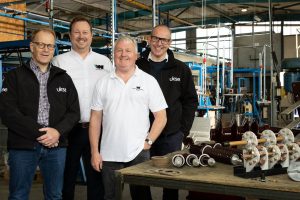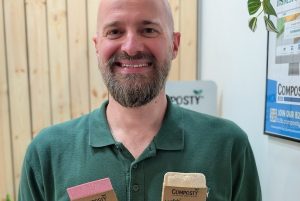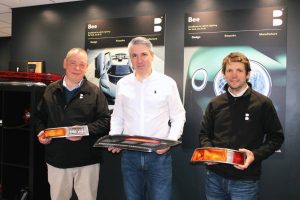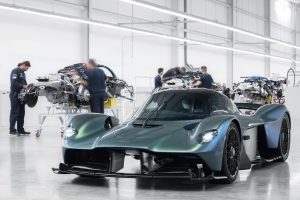Talking Business: George Gillespie, MIRA

A FOCUS on international opportunities and innovative new technologies is set to sustain growth rates at Midland-based automotive research and development organisation, MIRA – especially as the sector cannot rely forever on Jaguar Land Rover’s success. In the latest Talking Business interview, CEO George Gillespie explains to Duncan Tift, of TheBusinessDesk.com and John Leech, Head of Automotive, KPMG about his plan for the business.
COMMENTAutomotive research and development must stay in the West Midlands if success is to be maintained
|
GEORGE Gillespie has been CEO of vehicle engineering consultancy MIRA since 2009, a difficult time to join any organisation with such strong connections to an industry that was on its uppers but during the past four years the fortunes of the business – along with those of the industry it serves – have changed dramatically.
Sitting in his office at MIRA’s headquarters on the outskirts of Nuneaton, Gillespie is now confident the worst has been weathered and the “exciting” times lie ahead. There is much to be optimistic about – both for MIRA and the automotive industry in general. “I arrived with the aim of restoring a strong British brand back to where it should be – it was very much a transformation situation,” he says. MIRA began life in 1946 as the government-funded Motor Industry Research Association and has evolved into an independent vehicle engineering consultancy with aspirations to be a global player. As Gillespie explains, there are now three separate strands to the business: an engineering solutions consultancy; a testing services operation; and a property business that provides a technology park. The consultancy makes up the bulk (55%) of the business, followed by testing (40%) with the property division and others making up the final 5%. However, while the property operation is currently a small contributor this is set to change dramatically over the coming years as the technology park – which now benefits from Enterprise Zone status – grows. Growth is also coming from the international arms of the business as the company expands into territories where growth potential is strong. “We have spent the past four to five years restructuring the business,” says Gillespie. “Along with changes to sales and marketing, we have also invested overseas with a strong focus on the BRIC (Brazil, Russia, India and China) economies and we now have operations in Pune, Sao Paulo and Shanghai.” “We have focussed on the front-end pipeline with sales coming in from overseas and building up the team. We have added about 200 people during the past four years and have a workforce of just under 600 now. “As part of that I have a new board and at team management there’s a team of 14. That’s the thing I’m most proud of – getting that team in place. Getting all the foundations in place to develop a business that has a clear strategy and this is the point where it gets exciting. We want to inject some equity into the business and so the next five years are going to be the fun part.” He maintains that opportunities in the Automotive sector will be dependent on the markets – and is refreshingly realistic about how things might shape up over the next half-decade. “In the UK Jaguar Land Rover is clearly a dominant force and they are a big customer. Part of our success is due to their success,” he says. “Going forward, my view is that JLR has invested a lot in building up their own in-house capabilities, they have hired a lot of staff so in terms of the amount of business they outsource I don’t see that growth continuing for us. JLR’s success will continue but for us, the rate of growth will not continue as it was, it will plateau. “There are international opportunities, however, as JLR moves on to become a global business, with their operations in China, India, Brazil and Saudi Arabia. These are all territories we are in and part of our strategy is to go with them. Effectively, we will already be there to help them. We know their procedures and what they are trying to do. For example, in China our aim is to continue being an important partner with them.” Looking beyond JLR – as not all businesses are prepared to do these days – he says China remains a major market and one ripe with opportunities. “We have not been taking our fair share of that market and I want that to change. I spent a lot of time prior to MIRA in Asia and I’m aware of the opportunities that are out there. We have revamped and strengthened the team there and we are beginning to see growth there,” he says. The situation in India is slightly different. The economy there has not been doing so well of late, however, MIRA has committed resources to the country and will use the lull to build up its business in order to capitalise when things pick up. One of the most exciting places to be doing business over the next few years is likely to be Brazil and automotive manufacturers are keen to get a share of that growth. “We are one of the first engineering services providers to be there. Many of our competitors are not there yet and that gives us good first mover advantage,” says Gillespie. In the more traditional markets, things are a little more difficult. “There is a very strong indigenous base so it’s a tough market to break into. Part of our international strategy is to see how we might be able to step into Germany. I worked in Germany for three years and I know you have to step into that market in a very strong, coherent way. You have to have a strong presence and have German engineers in order to deliver what the market wants,” he says. MIRA’s strategy is to focus on its strengths – research and development. “R&D is one of the strengths of the UK automotive industry. I was talking with Joe Greenwell, head of the Automotive Investment Organisation recently and I asked what investment we were likely to get in the UK,” he says. “Due to the over-capacity in Europe, we are unlikely to get a new plant coming from the continent to the UK. What we may be able to do though is to increase our R&D capabilities because it’s what we’re good at. It’s what the technology park is all about. We want to offer a soft landing platform for firms looking to develop their R&D capabilities.” He quotes the example of newly-acquired tenant, Ashok Leyland. “Ashok Leyland has global aspirations in the bus and truck business. They are strong in India and have links into Japan. What they want to do is to move into Europe and they have recognised that if they want to sell trucks and buses in Europe they have to engineer in Europe because they have to touch the customer to find out what they want and they need European technology. “They looked all around Europe to decide where to place their European R&D centre and we convinced them MIRA was the place to come. They have all the testing facilities at their fingertips so they don’t have to go anywhere else. They have effectively created a European R&D centre at minimal cost.” It is a model being mapped out for other tenants; which during the past year have been strengthened by the likes of Bosch (Stuttgart), Lockheed Martin (US), Ashok Leyland (India) and Triumph (Hinckley). The technology park currently has 28 tenants and this is set to rise to 31 shortly. “We have three further announcements imminently; two of which are bigger than we have announced so far. The deals are done,” says Gillespie. So, is it difficult to attract foreign investment to the West Midlands?
“Getting them to come to the Midlands is not too difficult because it’s very expensive to relocate in London and the South East. There’s also not a lot of the automotive industry based there. Then it’s a decision about whether you move to a business park in Coventry, Warwick or Birmingham or you come here and that’s when we sell our unique capabilities including access to engineering and testing facilities. There’s a premium to being here.” He is also keen on seeing MIRA develop the region’s next technology cluster – intelligent mobility. “Intelligent mobility is all about the connective infrastructure of cars. We have Europe’s only Intelligent Mobility Test Facility. We have a series of tracks and our own 2G; 3G and wireless systems plus satellite denial to simulate driving conditions anywhere in the world,” he says. Intelligent mobility will focus on issues such as collision avoidance in real time, the development of new communications systems and a host of other connectivity solutions. Analysts believe that in the next three years around 50% of new cars will have effective connectivity systems installed and MIRA is already well positioned to capitalise on this fast-growing trend. “We have been doing research into this field for the past 20 years but only recently has this begun to commercialise. “However, we are already producing autonomous vehicles, only these are for the military (25% of the company’s business is with the military). We supplied the first fleet of autonomous vehicles to the MoD that are being used in theatre. These driverless vehicles are doing IED detection in Afghanistan. That has been a great learning experience for us but getting that technology out there and proving that it works has been a real boost to us. “There are civilian applications to be considered as well, such as mining, nuclear and others. Autonomous is designed for dull, dirty and dangerous tasks. It’s a much bigger challenge to do land-based autonomous vehicles as opposed to drones (or unmanned aerial vehicles (UAVs)) because of the terrain changes unlike the air. It will be a long time before you see robot fighting vehicles like you do in the movies but we are moving in that direction,” he says. Looking ahead, he says the aim of the technology park is to directly create 2,000 jobs by 2021 and about 3,000 indirectly. Support from local and central government to improve infrastructure is key to the growth strategy but all the ducks are lining up – improvement work on its junction with the A5 gets under way next month. “This business needs to grow to around £100m a year, that’s around the right kind of size for a business as capital intensive as MIRA. I’m confident we can achieve that. We have a very clear plan; we are around £45m at the moment but I can see us achieving our target in around five years,” he says. SectorsCommentsIf you'd like to leave a comment, please register now for free or login
|

 By John Leech, Birmingham-based UK head of automotive at KPMG
By John Leech, Birmingham-based UK head of automotive at KPMG
 “It’s a cascade sell. You first have to sell the UK, highlighting things such as the flexibility of the economy, stability of the currency and finally, the language. Most professional engineers in Asia will have English as a second language but few will have Spanish or German,” he says.
“It’s a cascade sell. You first have to sell the UK, highlighting things such as the flexibility of the economy, stability of the currency and finally, the language. Most professional engineers in Asia will have English as a second language but few will have Spanish or German,” he says.






